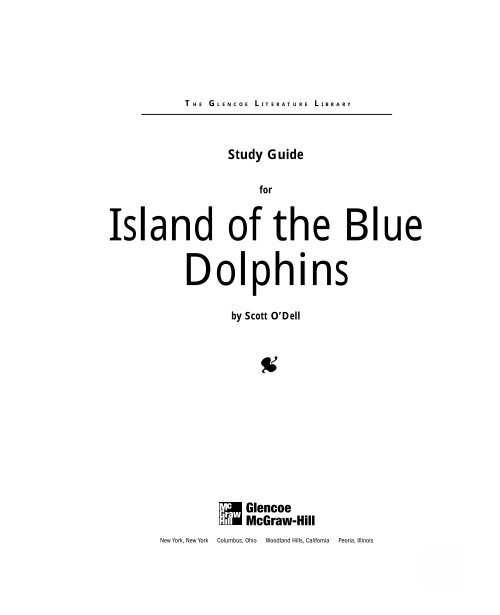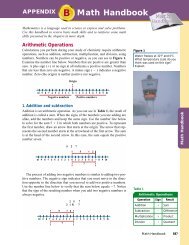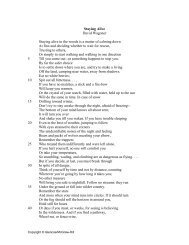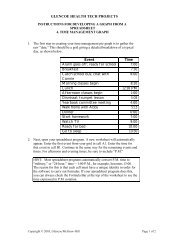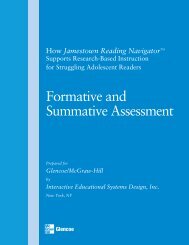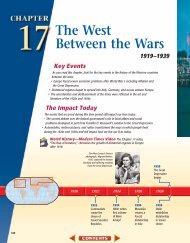Island of the Blue Dolphins Study Guide - Glencoe
Island of the Blue Dolphins Study Guide - Glencoe
Island of the Blue Dolphins Study Guide - Glencoe
You also want an ePaper? Increase the reach of your titles
YUMPU automatically turns print PDFs into web optimized ePapers that Google loves.
T HE G LENCOE L ITERATURE L IBRARY<br />
<strong>Study</strong> <strong>Guide</strong><br />
for<br />
<strong>Island</strong> <strong>of</strong> <strong>the</strong> <strong>Blue</strong><br />
<strong>Dolphins</strong><br />
by Scott O’Dell<br />
�<br />
i
Copyright © by The McGraw-Hill Companies, Inc.<br />
Many <strong>of</strong> my books are set in <strong>the</strong> past,<br />
but <strong>the</strong> problems <strong>of</strong> isolation, moral<br />
decisions, greed, need for love and<br />
affection are problems <strong>of</strong> today as well.<br />
Meet Scott O’Dell<br />
—Scott O’Dell<br />
Readers <strong>of</strong>ten wrote Scott O’Dell to ask<br />
him what it took to be a writer. His reply<br />
was <strong>the</strong> ability to stay seated. “Writing is<br />
hard,” he said, “harder than digging a ditch,<br />
and it requires patience.”<br />
O’Dell (1903–1989) began his fictionwriting<br />
career in <strong>the</strong> 1930s. By <strong>the</strong>n he had<br />
already worked as a Hollywood movie cameraman<br />
and as a book editor for a Los<br />
Angeles newspaper. He wrote three novels for<br />
adult readers before producing his first novel<br />
for young people, and his best-known book,<br />
<strong>Island</strong> <strong>of</strong> <strong>the</strong> <strong>Blue</strong> <strong>Dolphins</strong>. The book was an<br />
immediate success, winning <strong>the</strong> Newbery<br />
Medal in 1961 as well as many o<strong>the</strong>r awards.<br />
<strong>Island</strong> <strong>of</strong> <strong>the</strong> <strong>Blue</strong> <strong>Dolphins</strong>, like many<br />
<strong>of</strong> O’Dell’s books, takes place near <strong>the</strong><br />
California coast where O’Dell grew up. His<br />
family lived in several towns in sou<strong>the</strong>rn<br />
California, including San Pedro and Julian.<br />
San Pedro, located across <strong>the</strong> San Pedro<br />
Channel from San Nicolas <strong>Island</strong>, would<br />
inspire <strong>the</strong> setting <strong>of</strong> <strong>Island</strong> <strong>of</strong> <strong>the</strong> <strong>Blue</strong><br />
<strong>Dolphins</strong>. Julian was an old gold-mining<br />
town on <strong>the</strong> Mexican border. O’Dell<br />
became interested in <strong>the</strong> histories <strong>of</strong> Native<br />
Americans and Spanish settlers in sou<strong>the</strong>rn<br />
California. This interest led him to choose a<br />
Native American or Spanish heroine or hero<br />
for several <strong>of</strong> his novels.<br />
O’Dell also lived on Rattlesnake <strong>Island</strong><br />
(now called Terminal <strong>Island</strong>), across a channel<br />
from San Pedro. There, from his house at<br />
<strong>the</strong> water’s edge, he could listen to <strong>the</strong> constant<br />
sound <strong>of</strong> <strong>the</strong> waves and watch threemasted<br />
sailing ships pass by. “<strong>Island</strong> <strong>of</strong> <strong>the</strong> <strong>Blue</strong><br />
<strong>Dolphins</strong> . . . came directly from my memory<br />
<strong>of</strong> <strong>the</strong> years I lived at Rattlesnake <strong>Island</strong> and<br />
San Pedro,” O’Dell said. His love <strong>of</strong>, and<br />
respect for, <strong>the</strong> ocean are also reflected in <strong>the</strong><br />
novels Zia, The Black Pearl, Alexandra, and<br />
Venus Among <strong>the</strong> Fishes.<br />
While <strong>Island</strong> <strong>of</strong> <strong>the</strong> <strong>Blue</strong> <strong>Dolphins</strong> is generally<br />
regarded as O’Dell’s masterpiece, three <strong>of</strong> his<br />
o<strong>the</strong>r novels for young people have been widely<br />
praised. The King’s Fifth takes place in New<br />
Spain (now Mexico and <strong>the</strong> southwestern<br />
United States) at <strong>the</strong> time <strong>of</strong> Coronado’s expedition<br />
(1535). The main character, Esteban, is a<br />
young mapmaker who wants to be <strong>the</strong> first<br />
person to map <strong>the</strong> unexplored lands north <strong>of</strong><br />
present-day Mexico. Instead, he becomes<br />
caught up in a feverish search for gold. Sing<br />
Down <strong>the</strong> Moon is about <strong>the</strong> forced relocation<br />
<strong>of</strong> <strong>the</strong> Navajo people in <strong>the</strong> 1860s, seen through<br />
<strong>the</strong> eyes <strong>of</strong> a young Navajo girl. Streams to <strong>the</strong><br />
River, River to <strong>the</strong> Sea: A Novel <strong>of</strong> Sacagawea<br />
takes place during <strong>the</strong> Lewis and Clark expedition<br />
to <strong>the</strong> Pacific Northwest (1804–1806).<br />
O’Dell’s novels continue to appeal to<br />
readers because <strong>of</strong> his universal <strong>the</strong>mes. His<br />
characters meet basic human challenges and<br />
discover unexpected inner strengths.<br />
<strong>Island</strong> <strong>of</strong> <strong>the</strong> <strong>Blue</strong> <strong>Dolphins</strong> <strong>Study</strong> <strong>Guide</strong> 9
This extraordinary book . . . has <strong>the</strong> timeless,<br />
enduring quality <strong>of</strong> a classic.<br />
Introducing <strong>the</strong> Novel<br />
—Chicago Sunday Tribune<br />
If you were left alone on a deserted island,<br />
what would you have to do in order to survive?<br />
O’Dell explores this question in <strong>Island</strong><br />
<strong>of</strong> <strong>the</strong> <strong>Blue</strong> <strong>Dolphins</strong>. Survival is a <strong>the</strong>me that<br />
has appealed to novelists ever since Daniel<br />
Defoe published his popular Robinson Crusoe<br />
in 1719. In that work, Defoe describes how a<br />
shipwrecked English sailor uses his own cleverness<br />
to survive on a small tropical island.<br />
In <strong>Island</strong> <strong>of</strong> <strong>the</strong> <strong>Blue</strong> <strong>Dolphins</strong>, O’Dell tells<br />
<strong>the</strong> story <strong>of</strong> Karana, a Native American girl<br />
who survives alone on a wild, isolated island<br />
for many years in <strong>the</strong> mid-1800s. Karana is<br />
tested by her environment, even though it is<br />
a familiar one. The story is also about what it<br />
means to be human: Karana shows emotional<br />
and moral courage as she copes with a terrible<br />
loss. In <strong>the</strong> words <strong>of</strong> one reader, <strong>the</strong> novel is<br />
Santa Barbara Cha nel<br />
San Miguel<br />
Santa Rosa<br />
Pacific Ocean<br />
� Santa Barbara<br />
Santa Cruz<br />
San Nicolas<br />
Anacapa<br />
<strong>Island</strong>s<br />
CHANNEL<br />
Santa Barbara<br />
ISLANDS<br />
“A sad story, yes; but <strong>the</strong> sadness . . . is <strong>of</strong> a<br />
singularly inspiring kind.”<br />
Many readers admire <strong>Island</strong> <strong>of</strong> <strong>the</strong> <strong>Blue</strong><br />
<strong>Dolphins</strong> for its plain but vivid style and for <strong>the</strong><br />
au<strong>the</strong>ntic details that convey <strong>the</strong> natural richness<br />
<strong>of</strong> <strong>the</strong> setting. One critic has commented<br />
on <strong>the</strong> “beautiful feeling for <strong>the</strong> passing <strong>of</strong> <strong>the</strong><br />
seasons, and for <strong>the</strong> companionship <strong>of</strong>fered by<br />
<strong>the</strong> presence . . . <strong>of</strong> many animals.” Ano<strong>the</strong>r has<br />
noted that O’Dell never allows <strong>the</strong> narrative<br />
pace to slacken as he “intermingles accounts <strong>of</strong><br />
Karana’s day-to-day activities with <strong>the</strong> highlights<br />
<strong>of</strong> her adventures.” O’Dell’s style reflects<br />
<strong>the</strong> dignity and perception <strong>of</strong> <strong>the</strong> heroine in a<br />
moving tale <strong>of</strong> adventure and self-discovery.<br />
THE TIME AND PLACE<br />
The novel takes place on a remote California<br />
island in <strong>the</strong> mid-1800s. The setting was<br />
inspired by San Nicolas <strong>Island</strong>, one <strong>of</strong> <strong>the</strong><br />
Channel <strong>Island</strong>s. The Channel <strong>Island</strong>s are<br />
located in <strong>the</strong> Pacific Ocean less than one<br />
Los Angeles<br />
�<br />
San<br />
Pedro<br />
�<br />
San Pedro Channel<br />
Terminal<br />
<strong>Island</strong><br />
Santa<br />
Catalina<br />
Gulf <strong>of</strong><br />
Santa Catalina<br />
San<br />
Clemente<br />
CALIFORNIA<br />
�<br />
Scale in Miles<br />
0 25 50<br />
10 <strong>Island</strong> <strong>of</strong> <strong>the</strong> <strong>Blue</strong> <strong>Dolphins</strong> <strong>Study</strong> <strong>Guide</strong><br />
Copyright © by The McGraw-Hill Companies, Inc.
Copyright © by The McGraw-Hill Companies, Inc.<br />
hundred miles <strong>of</strong>f <strong>the</strong> coast <strong>of</strong> sou<strong>the</strong>rn<br />
California and separated from <strong>the</strong> mainland<br />
by <strong>the</strong> San Pedro and Santa Barbara<br />
Channels. These islands are home to a<br />
rich variety <strong>of</strong> sea birds and sea mammals,<br />
including sea lions and elephant seals,<br />
which thrive in its waters. Some <strong>of</strong> <strong>the</strong><br />
islands have rugged mountainous terrains<br />
and sea caves at <strong>the</strong> water’s edge.<br />
San Nicolas, <strong>the</strong> outermost <strong>of</strong> <strong>the</strong><br />
sou<strong>the</strong>rn Channel <strong>Island</strong>s, with an area <strong>of</strong><br />
about 22 square miles, is small enough to<br />
walk completely around in a day. The land<br />
rises above sea level to form a plateau,<br />
with an altitude <strong>of</strong> about 900 feet at its<br />
Did You Know?<br />
People began to live on <strong>the</strong> Channel <strong>Island</strong>s<br />
about ten thousand years ago. The first people<br />
to come to <strong>the</strong> area were <strong>the</strong> Chumash, who<br />
lived on <strong>the</strong> nor<strong>the</strong>rn islands and on <strong>the</strong> mainland<br />
<strong>of</strong> present-day California. The Chumash<br />
were excellent seafarers. They built large,<br />
sturdy canoes out <strong>of</strong> wooden planks, which<br />
allowed <strong>the</strong>m to associate with peoples on <strong>the</strong><br />
o<strong>the</strong>r islands and on <strong>the</strong> mainland.<br />
Between 2,500 and 4,000 years ago, a<br />
second cultural group, <strong>the</strong> Gabrielinos, began to<br />
settle <strong>the</strong> sou<strong>the</strong>rn Channel <strong>Island</strong>s, including<br />
San Nicolas. The name Gabrielinos comes from<br />
<strong>the</strong> title <strong>of</strong> <strong>the</strong> Spanish mission, or religious<br />
center, where <strong>the</strong>se people were sent in <strong>the</strong><br />
late 1700s. The Gabrielinos were related to <strong>the</strong><br />
Shoshone, who had lived in Sou<strong>the</strong>rn Oregon<br />
and Nevada before migrating to California.<br />
Although <strong>the</strong> Gabrielinos spoke a different<br />
language from that <strong>of</strong> <strong>the</strong> Chumash, <strong>the</strong> two<br />
groups had frequent contact through trade.<br />
From <strong>the</strong>ir neighbors to <strong>the</strong> north, <strong>the</strong><br />
Gabrielinos learned to build plank canoes. They<br />
also traded with groups on <strong>the</strong> mainland,<br />
exchanging soapstone from <strong>the</strong> island for<br />
highest point. Gullies that cut into <strong>the</strong><br />
land run down to <strong>the</strong> shore. Most <strong>of</strong> <strong>the</strong><br />
island is made up <strong>of</strong> sand dunes, whose<br />
sizes and shapes shift constantly because <strong>of</strong><br />
windstorms and ocean turbulence. The<br />
island has virtually no trees but is surrounded<br />
by a thick “forest” <strong>of</strong> giant kelp, a<br />
seaweed with large brown leaves. The kelp<br />
beds attract many forms <strong>of</strong> life, including<br />
rockfish, lobster, and sea otters.<br />
The Channel <strong>Island</strong>s have a mild yearround<br />
climate and are generally windy. Like<br />
mainland California, <strong>the</strong> islands are shaken<br />
by earthquakes, caused by sudden movements<br />
in <strong>the</strong> earth’s crust.<br />
seeds, deer hides, and rabbit skins. The ocean<br />
was an abundant source <strong>of</strong> food for <strong>the</strong><br />
Gabrielinos. They ga<strong>the</strong>red shellfish along <strong>the</strong><br />
shore; from <strong>the</strong>ir canoes, <strong>the</strong>y caught shark,<br />
bonito, halibut, sardines, and o<strong>the</strong>r fish. On<br />
land <strong>the</strong>y ga<strong>the</strong>red roots and seeds and hunted<br />
wild deer and antelope.<br />
Several thousand people were living on <strong>the</strong><br />
Channel <strong>Island</strong>s when a Portuguese explorer,<br />
Juan Rodríguez Cabrillo, arrived in 1542 in <strong>the</strong><br />
service <strong>of</strong> Spain. By <strong>the</strong> late 1700s, <strong>the</strong><br />
Spanish government had set up a system <strong>of</strong><br />
missions on <strong>the</strong> mainland to spread <strong>the</strong><br />
Catholic religion. Spanish leaders rounded up<br />
many <strong>of</strong> <strong>the</strong> islanders and brought <strong>the</strong>m to <strong>the</strong><br />
missions to convert <strong>the</strong>m to Christianity. O<strong>the</strong>rs<br />
were forced to work on Spanish-owned ranches.<br />
Many islanders died <strong>of</strong> measles and o<strong>the</strong>r new<br />
diseases introduced by <strong>the</strong> Europeans.<br />
Between 1812 and 1816, a wea<strong>the</strong>r pattern<br />
that made parts <strong>of</strong> <strong>the</strong> Pacific Ocean abnormally<br />
warm disrupted <strong>the</strong> food supply in <strong>the</strong> Channel<br />
<strong>Island</strong>s. This disaster, along with <strong>the</strong> danger<br />
posed by earthquakes, caused many <strong>of</strong> <strong>the</strong><br />
remaining islanders to move to <strong>the</strong> mainland.<br />
<strong>Island</strong> <strong>of</strong> <strong>the</strong> <strong>Blue</strong> <strong>Dolphins</strong> <strong>Study</strong> <strong>Guide</strong> 11
Before You Read<br />
<strong>Island</strong> <strong>of</strong> <strong>the</strong> <strong>Blue</strong> <strong>Dolphins</strong> Chapters 1–9<br />
FOCUS ACTIVITY<br />
How do people respond to a deep personal loss?<br />
Sharing Ideas<br />
With a partner, discuss different situations that can cause overwhelming sadness, such as <strong>the</strong><br />
death or absence <strong>of</strong> a loved one. How do people express <strong>the</strong>ir sadness over a great loss? What<br />
helps <strong>the</strong>m keep going and find purpose in life in spite <strong>of</strong> <strong>the</strong>ir sadness?<br />
Setting a Purpose<br />
Read to find out about a young girl who experiences a great loss.<br />
BACKGROUND<br />
Did You Know?<br />
Setting is <strong>the</strong> time and place in which <strong>the</strong> events <strong>of</strong> a story, novel, or play occur. Writers can<br />
reveal setting by describing such things as <strong>the</strong> landscape, wea<strong>the</strong>r, seasons, buildings, and clothing<br />
styles typical <strong>of</strong> a locale. They can also indicate <strong>the</strong> setting through <strong>the</strong> ways in which <strong>the</strong><br />
characters talk and behave. In <strong>Island</strong> <strong>of</strong> <strong>the</strong> <strong>Blue</strong> <strong>Dolphins</strong>, <strong>the</strong> setting is critical to <strong>the</strong> novel. In<br />
fact, <strong>the</strong> plot and <strong>the</strong> setting cannot be separated. Both <strong>the</strong> landscape <strong>of</strong> <strong>the</strong> island and <strong>the</strong> animals<br />
that live on it play important roles in <strong>the</strong> action <strong>of</strong> <strong>the</strong> book.<br />
The Aleuts<br />
At <strong>the</strong> opening <strong>of</strong> <strong>the</strong> novel, outsiders called Aleuts visit Karana’s island. The Aleuts were a<br />
native people who lived on <strong>the</strong> Alaska Peninsula and Aleutian <strong>Island</strong>s to <strong>the</strong> far north. The<br />
Aleuts lived in small villages and hunted various sea mammals from large open boats or small<br />
one- or two-person kayaks.<br />
The first Europeans to encounter <strong>the</strong> Aleuts were <strong>the</strong> Russians. In 1784 Russian fur traders<br />
arrived to hunt for sea otters, which were abundant in <strong>the</strong> region. They were quickly joined by<br />
British and U.S. fur traders. Competition for hunting grounds was fierce, and huge numbers <strong>of</strong><br />
sea otters were killed. To find more otters, fur traders and hunters traveled far down <strong>the</strong> Pacific<br />
Coast. By 1805 some were hunting in waters near <strong>the</strong> Channel <strong>Island</strong>s.<br />
VOCABULARY PREVIEW<br />
crevice [krev�is] n. narrow opening resulting from a split or crack<br />
headland [hed�lənd] n. point <strong>of</strong> unusually high land jutting out into a body <strong>of</strong> water<br />
pelt [pelt] n. <strong>the</strong> removed skin <strong>of</strong> a furry or woolly animal<br />
spring [sprinɡ] n. source <strong>of</strong> water flowing out <strong>of</strong> <strong>the</strong> earth<br />
stern [sturn] adj. harsh or severe in manner<br />
vow [vou] v. to promise solemnly<br />
12 <strong>Island</strong> <strong>of</strong> <strong>the</strong> <strong>Blue</strong> <strong>Dolphins</strong> <strong>Study</strong> <strong>Guide</strong><br />
Copyright © by The McGraw-Hill Companies, Inc.
Copyright © by The McGraw-Hill Companies, Inc.<br />
Name Name �������������������������������������������������������� �������������������������������������������������������� �������������������������������������������������������� �������������������������������������������������������� Date Date ������������������������� ������������������������� ������������������������� ������������������������� Class Class �����������������<br />
�����������������<br />
�����������������<br />
�����������������<br />
Active Reading<br />
<strong>Island</strong> <strong>of</strong> <strong>the</strong> <strong>Blue</strong> <strong>Dolphins</strong> Chapters 1–9<br />
A motive is a need or a desire that causes a person to act. Sometimes <strong>the</strong> author states a character’s<br />
motives. At o<strong>the</strong>r times, a reader must infer, or figure out, a character’s motives from details that<br />
<strong>the</strong> author gives. As you read Chapters 1–9, use <strong>the</strong> chart to note <strong>the</strong> motives in each situation.<br />
Action or Feeling Motive<br />
1. Tribe members keep watch over <strong>the</strong> The tribe wants to make sure that <strong>the</strong><br />
Aleut ship and Aleut camp. Aleuts do not leave without paying a fair<br />
price for <strong>the</strong> pelts.<br />
2. Karana joins her people on <strong>the</strong> ship<br />
that is taking <strong>the</strong>m from <strong>the</strong> island.<br />
3. Karana leaps from <strong>the</strong> ship and<br />
swims to shore.<br />
4. Karana vows to kill <strong>the</strong> wild dogs.<br />
5. Karana burns <strong>the</strong> village where she<br />
had lived with her tribe.<br />
6. Karana throws away <strong>the</strong> beads from<br />
<strong>the</strong> chest left by <strong>the</strong> Russian captain.<br />
7. Karana makes a spear and a bow<br />
and arrow.<br />
8. Every day Karana watches for <strong>the</strong><br />
ship’s return.<br />
<strong>Island</strong> <strong>of</strong> <strong>the</strong> <strong>Blue</strong> <strong>Dolphins</strong> <strong>Study</strong> <strong>Guide</strong> 13
Name �������������������������������������������������������� �������������������������������������������������������� Date ������������������������� ������������������������� Class �����������������<br />
�����������������<br />
Responding<br />
<strong>Island</strong> <strong>of</strong> <strong>the</strong> <strong>Blue</strong> <strong>Dolphins</strong> Chapters 1–9<br />
Personal Response<br />
Describe Karana’s response to her bro<strong>the</strong>r’s death and <strong>the</strong> absence <strong>of</strong> her tribe members.<br />
Do you think her response is unusual? What could explain her response? Before<br />
answering, review your discussion <strong>of</strong> loss in <strong>the</strong> Focus Activity.<br />
Analyzing Literature<br />
Recall and Interpret<br />
1. What do <strong>the</strong> Aleuts want to do on <strong>the</strong> island? Why do <strong>the</strong> Aleuts and <strong>the</strong> people<br />
<strong>of</strong> Ghalas-at fight? What is <strong>the</strong> result?<br />
2. Why and how do Karana’s people leave <strong>the</strong> island a year later?<br />
3. How does Ramo die? What does Karana promise to do after his death? Where<br />
does she go to live after her bro<strong>the</strong>r’s death?<br />
14 <strong>Island</strong> <strong>of</strong> <strong>the</strong> <strong>Blue</strong> <strong>Dolphins</strong> <strong>Study</strong> <strong>Guide</strong><br />
Copyright © by The McGraw-Hill Companies, Inc.
Copyright © by The McGraw-Hill Companies, Inc.<br />
Name �������������������������������������������������������� �������������������������������������������������������� Date ������������������������� ������������������������� Class �����������������<br />
�����������������<br />
Responding<br />
<strong>Island</strong> <strong>of</strong> <strong>the</strong> <strong>Blue</strong> <strong>Dolphins</strong> Chapters 1–9<br />
Analyzing Literature (continued)<br />
Evaluate and Connect<br />
4. What hints suggest that something bad will happen to Karana’s people before <strong>the</strong><br />
Aleuts leave?<br />
5. Why must Karana make weapons for herself? Why is she fearful about doing this?<br />
Do you think her fear is reasonable?<br />
Literature and Writing<br />
Character Pr<strong>of</strong>ile<br />
What is your first impression <strong>of</strong> Karana? Does she seem to be someone you would<br />
like to know? Write a paragraph in which you give your opinion <strong>of</strong> <strong>the</strong> main character<br />
<strong>of</strong> <strong>the</strong> novel. Before you write, review Karana’s actions and <strong>the</strong> motives behind<br />
<strong>the</strong>m, as you recorded <strong>the</strong>m on your Active Reading chart. Use this information to<br />
make some general statements about her personality. Is she brave, confident, quiet,<br />
perceptive, or something else? What is important to her? What strengths does she<br />
have? How do her hopes, fears, and actions reflect who she is?<br />
Extending Your Response<br />
Literature Groups<br />
At <strong>the</strong> end <strong>of</strong> Chapter 9, Karana is totally alone on <strong>the</strong> island and has several problems<br />
to solve. With your group, make a list <strong>of</strong> <strong>the</strong> problems she faces. Then, brainstorm<br />
possible solutions for each problem. When brainstorming, write down as many<br />
ideas as you can think <strong>of</strong> without rating <strong>the</strong>m or criticizing <strong>the</strong>m. Record your ideas<br />
in <strong>the</strong> form <strong>of</strong> a web or a chart. Once you have recorded everyone’s ideas, review and<br />
discuss <strong>the</strong>m. Circle <strong>the</strong> solutions that fit Karana’s situation <strong>the</strong> best or seem to be<br />
<strong>the</strong> most likely to succeed. Then share your possible solutions with o<strong>the</strong>r groups.<br />
Ecology Connection<br />
Karana is worried that <strong>the</strong> Aleuts are killing too many sea otters. Her fa<strong>the</strong>r says<br />
many otters are hiding and will return when <strong>the</strong> hunters leave. Find out what laws<br />
exist to regulate hunting today. You may want to investigate <strong>the</strong> laws in your own<br />
state by contacting <strong>the</strong> Fish and Game Commission. Or you may want to research<br />
international agreements that concern <strong>the</strong> hunting <strong>of</strong> sea creatures such as whales<br />
and dolphins. Share your information with <strong>the</strong> class. Does your research most closely<br />
support Karana’s view <strong>of</strong> hunting or her fa<strong>the</strong>r’s?<br />
Save your work for your portfolio.<br />
<strong>Island</strong> <strong>of</strong> <strong>the</strong> <strong>Blue</strong> <strong>Dolphins</strong> <strong>Study</strong> <strong>Guide</strong> 15
Before You Read<br />
<strong>Island</strong> <strong>of</strong> <strong>the</strong> <strong>Blue</strong> <strong>Dolphins</strong> Chapters 10–19<br />
FOCUS ACTIVITY<br />
Think about, or look up, <strong>the</strong> meaning <strong>of</strong> <strong>the</strong> word resourceful. Define this term in your own words.<br />
Think–Pair–Share<br />
With a partner, discuss your definitions <strong>of</strong> <strong>the</strong> word resourceful. Then create a two-column chart.<br />
In <strong>the</strong> left column, list difficult situations a person might face. In <strong>the</strong> right column, describe how<br />
a resourceful person might respond to each situation.<br />
Setting a Purpose<br />
Read to find out how Karana makes use <strong>of</strong> <strong>the</strong> resources available to her on <strong>the</strong> island.<br />
BACKGROUND<br />
Did You Know?<br />
An author’s style includes his or her word choice, sentence structure, and choice <strong>of</strong> figurative<br />
language and imagery. Scott O’Dell’s writing style suits his narrator. Karana leads a simple life<br />
and has never been beyond her own tiny island, so O’Dell uses simple language and makes concrete<br />
observations ra<strong>the</strong>r than expressing complicated ideas. O’Dell also uses images that are<br />
based on Karana’s own experiences. The swimming and leaping dolphins, for example, crisscross<br />
each o<strong>the</strong>r “as if <strong>the</strong>y were weaving a piece <strong>of</strong> cloth with <strong>the</strong>ir broad snouts.”<br />
Elephant Seals<br />
One <strong>of</strong> <strong>the</strong> largest animals on Karana’s island is <strong>the</strong> elephant seal, also called <strong>the</strong> sea elephant.<br />
Like o<strong>the</strong>r seals, <strong>the</strong> elephant seal is a powerful swimmer with a streamlined body and four short<br />
limbs that end in flippers. The elephant seal received its name because <strong>of</strong> its large size—males<br />
weigh almost four tons—and because <strong>of</strong> <strong>the</strong> chunky but flexible snout that hangs down over <strong>the</strong><br />
mouth <strong>of</strong> <strong>the</strong> male. During <strong>the</strong> breeding season, <strong>the</strong> males, called bulls, frequently engage in<br />
fights as <strong>the</strong>y establish <strong>the</strong>ir territories and try to attract females.<br />
VOCABULARY PREVIEW<br />
clamor [klam�ər] n. loud, continuous noise<br />
lure [loor] n. bait; thing that attracts<br />
mourning [mo�r�ninɡ] n. feeling <strong>of</strong> sorrow after a death<br />
omen [ō�mən] n. sign <strong>of</strong> something good or bad to come<br />
pitch [pich] n. dark, sticky substance from trees or o<strong>the</strong>r plants, used for waterpro<strong>of</strong>ing or for<br />
plugging holes<br />
reef [rēf] n. low ridge <strong>of</strong> rocks, sand, or coral that rises above <strong>the</strong> surface <strong>of</strong> a body <strong>of</strong> water<br />
rival [r�¯�vəl] n. one who competes with ano<strong>the</strong>r<br />
scarce [skārs] adj. hard to find; few in number<br />
swarm [swo�rm] n. large number <strong>of</strong> things in busy motion<br />
16 <strong>Island</strong> <strong>of</strong> <strong>the</strong> <strong>Blue</strong> <strong>Dolphins</strong> <strong>Study</strong> <strong>Guide</strong><br />
Copyright © by The McGraw-Hill Companies, Inc.
Copyright © by The McGraw-Hill Companies, Inc.<br />
Name �������������������������������������������������������� �������������������������������������������������������� Date ������������������������� ������������������������� Class �����������������<br />
�����������������<br />
Active Reading<br />
<strong>Island</strong> <strong>of</strong> <strong>the</strong> <strong>Blue</strong> <strong>Dolphins</strong> Chapters 10–19<br />
Some <strong>of</strong> <strong>the</strong> traits in <strong>the</strong> list below fit Karana and some do not. Select four traits that describe her<br />
well and write <strong>the</strong>m in <strong>the</strong> chart. Then, for each trait, list at least one action in Chapters 10–19 in<br />
which Karana exhibits <strong>the</strong> trait.<br />
intelligent funny responsible caring honest<br />
realistic hardworking problem-solver confident generous<br />
Trait Actions that Demonstrate Trait<br />
problem-solver Builds a fire to try to force dogs out <strong>of</strong> cave so she can shoot at <strong>the</strong>m.<br />
<strong>Island</strong> <strong>of</strong> <strong>the</strong> <strong>Blue</strong> <strong>Dolphins</strong> <strong>Study</strong> <strong>Guide</strong> 17
Name �������������������������������������������������������� �������������������������������������������������������� Date ������������������������� ������������������������� Class �����������������<br />
�����������������<br />
Responding<br />
<strong>Island</strong> <strong>of</strong> <strong>the</strong> <strong>Blue</strong> <strong>Dolphins</strong> Chapters 10–19<br />
Personal Response<br />
Imagine yourself in Karana’s position. In what ways would you be better prepared<br />
than she is to handle <strong>the</strong> situations with which she is faced? In what ways would you<br />
be less well prepared than she is? Explain.<br />
Analyzing Literature<br />
Recall and Interpret<br />
1. Why does Karana decide to canoe to <strong>the</strong> country lying to <strong>the</strong> east? What causes<br />
her to return to <strong>the</strong> island? Why is she happy after she returns?<br />
2. What materials does Karana use to build her house? How does she assemble <strong>the</strong>m?<br />
3. Who is Rontu? How does Rontu change Karana’s life? How does he help keep<br />
her safe?<br />
18 <strong>Island</strong> <strong>of</strong> <strong>the</strong> <strong>Blue</strong> <strong>Dolphins</strong> <strong>Study</strong> <strong>Guide</strong><br />
Copyright © by The McGraw-Hill Companies, Inc.
Copyright © by The McGraw-Hill Companies, Inc.<br />
Name �������������������������������������������������������� �������������������������������������������������������� Date ������������������������� ������������������������� Class �����������������<br />
�����������������<br />
Responding<br />
<strong>Island</strong> <strong>of</strong> <strong>the</strong> <strong>Blue</strong> <strong>Dolphins</strong> Chapters 10–19<br />
Analyzing Literature (continued)<br />
Evaluate and Connect<br />
4. Why does Karana feel that she must be prepared to flee from <strong>the</strong> island? What<br />
resourceful steps does she take to be ready to flee? Before answering, review <strong>the</strong><br />
chart you made in <strong>the</strong> Focus Activity.<br />
5. Were you surprised that Karana rescued <strong>the</strong> wounded Rontu? Explain. In what<br />
earlier scene did Karana also decide not to kill a wounded animal? What do<br />
<strong>the</strong>se acts say about her?<br />
Literature and Writing<br />
An <strong>Island</strong> <strong>of</strong> Caves<br />
The <strong>Island</strong> <strong>of</strong> <strong>the</strong> <strong>Blue</strong> <strong>Dolphins</strong> has many caves. In Chapters 10–19, important<br />
scenes take place in three <strong>of</strong> <strong>the</strong>se caves. Identify <strong>the</strong>se three scenes. Then, write a<br />
brief report describing where <strong>the</strong> caves are located, what <strong>the</strong>y look like from <strong>the</strong><br />
inside and <strong>the</strong> outside, and what events occur in <strong>the</strong>m.<br />
Extending Your Response<br />
Literature Groups<br />
Dividing <strong>the</strong> task among members <strong>of</strong> your group, skim Chapters 10–19 for scenes<br />
that show Karana observing or interacting with animals. Toge<strong>the</strong>r, discuss those<br />
scenes. How would you summarize her relation to animals? Has her attitude toward<br />
animals changed in this section <strong>of</strong> <strong>the</strong> book?<br />
Learning for Life<br />
Karana’s skills help her survive on <strong>the</strong> <strong>Island</strong> <strong>of</strong> <strong>the</strong> <strong>Blue</strong> <strong>Dolphins</strong>. Name some skills<br />
that people need to survive in today’s world. Prepare a list <strong>of</strong> six to ten survival skills<br />
for <strong>the</strong> twenty-first century. The knowledge and use <strong>of</strong> <strong>the</strong>se skills should help people<br />
function better in <strong>the</strong>ir day-to-day lives. As you make your list, think about <strong>the</strong>se general<br />
questions: Does Karana possess skills and abilities that would also be useful to<br />
people living in a modern society? Do people need physical skills as well as mental<br />
skills to survive today? Do men and women need <strong>the</strong> same skills? What survival skills<br />
have you already learned? What survival skills do you expect to develop?<br />
Save your work for your portfolio.<br />
<strong>Island</strong> <strong>of</strong> <strong>the</strong> <strong>Blue</strong> <strong>Dolphins</strong> <strong>Study</strong> <strong>Guide</strong> 19
Before You Read<br />
<strong>Island</strong> <strong>of</strong> <strong>the</strong> <strong>Blue</strong> <strong>Dolphins</strong> Chapters 20–29<br />
FOCUS ACTIVITY<br />
What mental and emotional changes do people typically undergo as <strong>the</strong>y grow from adolescence<br />
into adulthood?<br />
Quickwrite<br />
Write about how people at different levels <strong>of</strong> maturity might cope with fear, hardship, disappointment,<br />
and personal disagreements. How would a child, in comparison with a teenager, deal with<br />
<strong>the</strong>se things? How would an adult? Consider reasons why <strong>the</strong>ir abilities to cope might differ.<br />
Setting a Purpose<br />
Read to find out how Karana continues to change in response to her experiences on <strong>the</strong> <strong>Island</strong> <strong>of</strong><br />
<strong>the</strong> <strong>Blue</strong> <strong>Dolphins</strong>.<br />
BACKGROUND<br />
The Channel <strong>Island</strong>s Today<br />
Today, five <strong>of</strong> <strong>the</strong> Channel <strong>Island</strong>s <strong>of</strong>f <strong>the</strong> coast <strong>of</strong> California make up <strong>the</strong> Channel <strong>Island</strong>s<br />
National Park—San Miguel, Santa Rosa, Santa Barbara, Anacapa, and Santa Cruz. About onehalf<br />
<strong>of</strong> <strong>the</strong> acreage <strong>of</strong> <strong>the</strong> park is under <strong>the</strong> ocean, extending one mile out from <strong>the</strong> shorelines<br />
around <strong>the</strong> islands. Most <strong>of</strong> <strong>the</strong> islands have primitive campgrounds and hiking trails. San<br />
Nicolas, where <strong>Island</strong> <strong>of</strong> <strong>the</strong> <strong>Blue</strong> <strong>Dolphins</strong> takes place, and San Clemente are owned today by <strong>the</strong><br />
U.S. Navy and are used for military training and research. Santa Catalina, also called Catalina<br />
<strong>Island</strong>, is a resort area.<br />
Did You Know?<br />
The plot <strong>of</strong> a novel is <strong>the</strong> sequence <strong>of</strong> events in <strong>the</strong> story. Most plots unfold in five steps. In <strong>the</strong> exposition,<br />
<strong>the</strong> author introduces <strong>the</strong> characters and sets up <strong>the</strong> conflict. The rising action includes events<br />
in which <strong>the</strong> conflict is developed. The climax is <strong>the</strong> point <strong>of</strong> greatest suspense, and <strong>the</strong> falling action<br />
includes events that happen after <strong>the</strong> climax. The resolution is <strong>the</strong> final outcome <strong>of</strong> <strong>the</strong> conflict.<br />
In <strong>Island</strong> <strong>of</strong> <strong>the</strong> <strong>Blue</strong> <strong>Dolphins</strong>, <strong>the</strong> exposition is presented in Chapters 1–9, which tell how Karana<br />
ends up on <strong>the</strong> island alone. Chapters 10–19 provide <strong>the</strong> rising action, showing Karana confronting<br />
<strong>the</strong> problem <strong>of</strong> living alone. The last section, which you are about to read, presents <strong>the</strong><br />
climax, <strong>the</strong> falling action, and <strong>the</strong> resolution.<br />
VOCABULARY PREVIEW<br />
banks [banɡks] n. mounds, piles, or ridges<br />
glimpse [ɡlimps] n. brief look<br />
hasten [hā�sən] v. to move quickly<br />
horizon [hə r�¯�zən] n. line where earth and sky meet<br />
reproachfully [ri prōch�fəl ē] adv. in a disapproving manner<br />
snares [snārz] n. traps<br />
victor [vik�tər] n. winner; one who defeats an opponent<br />
wreckage [rek�ij] n. broken and disordered parts from something wrecked<br />
20 <strong>Island</strong> <strong>of</strong> <strong>the</strong> <strong>Blue</strong> <strong>Dolphins</strong> <strong>Study</strong> <strong>Guide</strong><br />
Copyright © by The McGraw-Hill Companies, Inc.
Copyright © by The McGraw-Hill Companies, Inc.<br />
Name �������������������������������������������������������� �������������������������������������������������������� Date ������������������������� ������������������������� Class �����������������<br />
�����������������<br />
Active Reading<br />
<strong>Island</strong> <strong>of</strong> <strong>the</strong> <strong>Blue</strong> <strong>Dolphins</strong> Chapters 20–29<br />
In Chapters 20–29, Karana’s attitude toward living on <strong>the</strong> island changes. As you read this<br />
section, use as many ovals as you need to record <strong>the</strong> events that cause or reveal her changing attitude.<br />
Event:<br />
Event:<br />
The Aleut ship arrives.<br />
Event:<br />
Event:<br />
Event:<br />
Event:<br />
<strong>Island</strong> <strong>of</strong> <strong>the</strong> <strong>Blue</strong> <strong>Dolphins</strong> <strong>Study</strong> <strong>Guide</strong> 21
Name �������������������������������������������������������� �������������������������������������������������������� Date ������������������������� ������������������������� Class �����������������<br />
�����������������<br />
Responding<br />
<strong>Island</strong> <strong>of</strong> <strong>the</strong> <strong>Blue</strong> <strong>Dolphins</strong> Chapters 20–29<br />
Personal Response<br />
Might Karana have reacted differently if Tutok had been a young man instead <strong>of</strong> a<br />
young woman? Why or why not?<br />
Analyzing Literature<br />
Recall and Interpret<br />
1. How does Karana react when she sees <strong>the</strong> Aleut ship? What conflicting feelings<br />
does Karana have about Tutok? How do her feelings change and why?<br />
2. How does Karana’s animal family grow and change? Why does Karana vow never<br />
to kill ano<strong>the</strong>r animal or bird?<br />
3. Why is Karana eager to greet <strong>the</strong> men from <strong>the</strong> unfamiliar ship? When <strong>the</strong> ship<br />
returns, what does Karana learn about her people? Where is she now headed?<br />
22 <strong>Island</strong> <strong>of</strong> <strong>the</strong> <strong>Blue</strong> <strong>Dolphins</strong> <strong>Study</strong> <strong>Guide</strong><br />
Copyright © by The McGraw-Hill Companies, Inc.
Copyright © by The McGraw-Hill Companies, Inc.<br />
Name �������������������������������������������������������� �������������������������������������������������������� Date ������������������������� ������������������������� Class �����������������<br />
�����������������<br />
Responding<br />
<strong>Island</strong> <strong>of</strong> <strong>the</strong> <strong>Blue</strong> <strong>Dolphins</strong> Chapters 20–29<br />
Analyzing Literature (continued)<br />
Evaluate and Connect<br />
4. Earlier in <strong>the</strong> book, Karana nursed Rontu back to health, even though he was<br />
one <strong>of</strong> <strong>the</strong> wild dogs that had killed her bro<strong>the</strong>r. What similar situation occurs in<br />
this section <strong>of</strong> <strong>the</strong> novel? Why is <strong>the</strong> situation similar?<br />
5. When she goes to meet <strong>the</strong> white men, why does Karana draw <strong>the</strong> mark on her<br />
face that indicates that she is still unmarried?<br />
Literature and Writing<br />
More Than <strong>the</strong> Facts<br />
Figurative language communicates ideas beyond <strong>the</strong> literal meaning <strong>of</strong> words. Types<br />
<strong>of</strong> figurative language include personification, in which a human quality is given to<br />
an animal, object, or idea; metaphor, in which a comparison between seemingly<br />
unlike things is implied; and simile, in which unlike things are compared using<br />
words such as like or as.<br />
Extending Your Response<br />
Literature Groups<br />
Is it more important to learn to rely on yourself or to learn to love and accept o<strong>the</strong>rs?<br />
In your group, debate this question. Before you begin, review <strong>the</strong> Quickwrite you did<br />
for <strong>the</strong> Focus Activity. To support your point <strong>of</strong> view, be sure to give evidence from<br />
<strong>the</strong> novel as well as from your own experience.<br />
Art Connection<br />
Karana is proud <strong>of</strong> <strong>the</strong> beautiful skirt <strong>of</strong> cormorant fea<strong>the</strong>rs that she has made, and<br />
she is happy when Tutok admires it. When she goes to meet <strong>the</strong> ship that will take<br />
her from <strong>the</strong> island, she wears <strong>the</strong> skirt along with her otter cape and treasured black<br />
bead necklace. Use O’Dell’s description <strong>of</strong> Karana’s appearance to create a drawing,<br />
painting, or cardboard figure <strong>of</strong> Karana in her finery. You may wish to ga<strong>the</strong>r fea<strong>the</strong>rs<br />
and o<strong>the</strong>r materials to use in creating <strong>the</strong> clothing and jewelry. If you draw <strong>the</strong>se<br />
items instead, try to convey <strong>the</strong>ir different colors and textures.<br />
Save your work for your portfolio.<br />
<strong>Island</strong> <strong>of</strong> <strong>the</strong> <strong>Blue</strong> <strong>Dolphins</strong> <strong>Study</strong> <strong>Guide</strong> 23
Name �������������������������������������������������������� �������������������������������������������������������� Date ������������������������� ������������������������� Class �����������������<br />
�����������������<br />
Responding<br />
<strong>Island</strong> <strong>of</strong> <strong>the</strong> <strong>Blue</strong> <strong>Dolphins</strong><br />
Personal Response<br />
Did you find <strong>the</strong> story sad or inspiring or both? Would you use some o<strong>the</strong>r word to<br />
describe it? Explain your answer.<br />
Writing About <strong>the</strong> Novel<br />
Have you ever heard <strong>the</strong> expression “No man is an island”? What do you think this<br />
statement means? Do you agree with it? Would <strong>the</strong> author <strong>of</strong> <strong>Island</strong> <strong>of</strong> <strong>the</strong> <strong>Blue</strong><br />
<strong>Dolphins</strong> agree with it? Answer <strong>the</strong>se questions in a well-organized paragraph.<br />
Save your work for your portfolio.<br />
24 <strong>Island</strong> <strong>of</strong> <strong>the</strong> <strong>Blue</strong> <strong>Dolphins</strong> <strong>Study</strong> <strong>Guide</strong><br />
Copyright © by The McGraw-Hill Companies, Inc.
Copyright © by The McGraw-Hill Companies, Inc.<br />
Name �������������������������������������������������������� Date ������������������������� Class �����������������<br />
A Mo<strong>the</strong>r’s Yarn<br />
a Saami story adapted by James Riordan<br />
Before You Read<br />
Focus Question<br />
Think about people who achieved greatness or have survived difficult experiences. What combination<br />
<strong>of</strong> personality traits, beliefs, and skills do <strong>the</strong>se people seem to have?<br />
Background<br />
“A Mo<strong>the</strong>r’s Yarn” is a lesson tale from <strong>the</strong> Saami (or Sami) people <strong>of</strong> Lappland, a region <strong>of</strong><br />
Nor<strong>the</strong>rn Europe near <strong>the</strong> Arctic Circle. The Saami are a native people who occupied this area<br />
<strong>of</strong> Europe long before Swedish, Finnish, and Viking people settled <strong>the</strong>re. In this story, a young<br />
woman must learn to build <strong>the</strong> confidence and skills she needs to survive on her own in <strong>the</strong> wild.<br />
Responding to <strong>the</strong> Reading<br />
1. Explain <strong>the</strong> difference between <strong>the</strong> old man and his wife in “A Mo<strong>the</strong>r’s Yarn.”<br />
2. Why does Nastai’s fa<strong>the</strong>r leave her? How does she feel when she finds herself completely<br />
alone?<br />
3. How is Nastai able to turn her life around? What qualities does she display?<br />
4. Making Connections What do Karana in <strong>Island</strong> <strong>of</strong> <strong>the</strong> <strong>Blue</strong> <strong>Dolphins</strong> and Nastai in “A<br />
Mo<strong>the</strong>r’s Yarn” have in common?<br />
Plan for Survival<br />
Could you survive on your own in a new situation, without familiar people and conveniences?<br />
Imagine yourself stranded in one <strong>of</strong> <strong>the</strong> following places: a dark forest, an island like <strong>the</strong> <strong>Island</strong> <strong>of</strong><br />
<strong>the</strong> <strong>Blue</strong> <strong>Dolphins</strong>, or a large city. Think about what you would do to find food and shelter. What<br />
past memories and experiences would give you <strong>the</strong> knowledge and strength to survive? Where<br />
might you seek companionship or relaxing activities? Create a plan for survival. Include practical<br />
survival ideas as well as thoughts that would give you emotional strength. Think about what your<br />
life would be like in a new place if you could succeed and do well.<br />
<strong>Island</strong> <strong>of</strong> <strong>the</strong> <strong>Blue</strong> <strong>Dolphins</strong> <strong>Study</strong> <strong>Guide</strong> 25
Name �������������������������������������������������������� Date ������������������������� Class �����������������<br />
Alone Maya Angelou<br />
Before You Read<br />
Focus Question<br />
What is <strong>the</strong> difference between being alone and feeling lonely? How do you keep yourself from<br />
feeling loneliness?<br />
Background<br />
Maya Angelou is an African American writer, poet, playwright, actor, and political activist. She<br />
is best known for her autobiographical classic I Know Why <strong>the</strong> Caged Bird Sings, which is about<br />
her childhood struggles with racism, abuse, and poverty. Angelou’s five collections <strong>of</strong> poetry focus<br />
on <strong>the</strong> African American experience and <strong>the</strong> basic human struggle for happiness, companionship,<br />
freedom, and understanding. In this poem, she writes about a person’s need to feel truly<br />
connected to o<strong>the</strong>r people.<br />
Responding to <strong>the</strong> Reading<br />
1. What does <strong>the</strong> speaker mean when she says she wants to “find her soul a home”? What does<br />
she need?<br />
2. In what ways can a person with a great deal <strong>of</strong> money who is surrounded by people still feel alone?<br />
3. Why do you think Angelou believes <strong>the</strong> race <strong>of</strong> man is suffering? What is her answer to<br />
<strong>the</strong> problem?<br />
4. Making Connections Being without human companionship, and <strong>the</strong>n finding out every<br />
member <strong>of</strong> her community has died, affects Karana in different ways. Despite her isolation,<br />
why is she <strong>of</strong>ten without loneliness? By <strong>the</strong> end <strong>of</strong> <strong>the</strong> novel has her soul “found a home” on<br />
<strong>the</strong> island? Do you believe <strong>the</strong> novel illustrates <strong>the</strong> idea that a person can make it alone, or<br />
does it emphasize <strong>the</strong> idea that “. . . Nobody / Can make it out here alone”?<br />
Connecting to O<strong>the</strong>rs<br />
With a partner, think about people in <strong>the</strong> world and in your own community who might be experiencing<br />
loneliness. You might consider people in hospitals, <strong>the</strong> elderly in nursing homes, students in<br />
new schools, people moving into new neighborhoods, and people without homes. Think about how<br />
loneliness might affect each person. Then write a paragraph about small ways in which people can<br />
try to ease some <strong>of</strong> this loneliness.<br />
26 <strong>Island</strong> <strong>of</strong> <strong>the</strong> <strong>Blue</strong> <strong>Dolphins</strong> <strong>Study</strong> <strong>Guide</strong><br />
Copyright © by The McGraw-Hill Companies, Inc.
Copyright © by The McGraw-Hill Companies, Inc.<br />
Name �������������������������������������������������������� Date ������������������������� Class �����������������<br />
California Sea Otters<br />
Richard Wolkomir<br />
Before You Read<br />
Focus Question<br />
Under what circumstances might a wild animal need <strong>the</strong> help <strong>of</strong> a human?<br />
Background<br />
Freelance writer Richard Wolkomir is very interested in endangered animals. With his wife Joyce<br />
Wolkomir, he wrote a book on <strong>the</strong> subject called Junkyard Bandicoots and O<strong>the</strong>r Tales <strong>of</strong> <strong>the</strong><br />
World’s Endangered Species. Wolkomir traveled to <strong>the</strong> coastal town <strong>of</strong> Monterey, California, to<br />
write this article for National Geographic magazine.<br />
Responding to <strong>the</strong> Reading<br />
1. What are three dangers that California sea otters face?<br />
2. How do mo<strong>the</strong>r sea otters protect baby sea otters? What do mo<strong>the</strong>rs teach <strong>the</strong>ir <strong>of</strong>fspring?<br />
3. How do people at <strong>the</strong> Monterey Bay Aquarium try to help orphaned sea otters?<br />
4. How do California sea otters affect <strong>the</strong> environment?<br />
5. Making Connections What observations does Karana make about sea otters that this article<br />
proves to be correct?<br />
Creating a Comic Strip<br />
Create a comic strip that features a California sea otter as a main character. You may want to<br />
include humans in your comic strip, or you may want to focus on a family <strong>of</strong> otters. You may<br />
want to let <strong>the</strong> otters talk, or you may want to tell a story using only pictures. Refer to <strong>the</strong> article<br />
for information about <strong>the</strong> appearance and behavior <strong>of</strong> sea otters, and use those details in your<br />
comic strip.<br />
<strong>Island</strong> <strong>of</strong> <strong>the</strong> <strong>Blue</strong> <strong>Dolphins</strong> <strong>Study</strong> <strong>Guide</strong> 27
Name �������������������������������������������������������� Date ������������������������� Class �����������������<br />
The Fish Elizabeth Bishop<br />
pete at <strong>the</strong> seashore Don Marquis<br />
Before You Read<br />
Focus Question<br />
Think about a striking or interesting feature <strong>of</strong> a favorite pet or <strong>of</strong> an animal in <strong>the</strong> wild. What<br />
personality traits can you find in <strong>the</strong> animal that are similar to human traits?<br />
Background<br />
Elizabeth Bishop (1911–1979) was an American writer most well-kown for her clever and<br />
descriptive poetry. A Massachusetts native, Bishop spent time living in San Francisco, California;<br />
Key West, Florida; Mexico; and Brazil. In addition to poetry, Bishop wrote a travel book and<br />
translations <strong>of</strong> twentieth-century Brazilian poetry. In this poem, a person out for a casual day <strong>of</strong><br />
fishing takes a close look at a fish caught on a hook. Don Marquis (1878–1937) is an American<br />
writer who worked as a poet, a playwright, an editor, and a journalist. His most famous characters<br />
are Archy <strong>the</strong> cockroach and Mehitabel <strong>the</strong> cat, whose humorous and <strong>of</strong>ten clever ideas and<br />
observations appear in a series <strong>of</strong> poems. In this poem, Marquis writes from <strong>the</strong> point <strong>of</strong> view <strong>of</strong> a<br />
dog running on <strong>the</strong> beach.<br />
Responding to <strong>the</strong> Reading<br />
1. Why does <strong>the</strong> speaker call <strong>the</strong> hooks and lines attached to <strong>the</strong> lower lip <strong>of</strong> <strong>the</strong> fish “medals<br />
with <strong>the</strong>ir ribbons” and a “five-haired beard <strong>of</strong> wisdom”? What story do <strong>the</strong>se hooks and lines<br />
tell about <strong>the</strong> life <strong>of</strong> <strong>the</strong> fish?<br />
2. Why do you think <strong>the</strong> speaker lets <strong>the</strong> fish go?<br />
3. According to <strong>the</strong> Marquis poem, what effect does <strong>the</strong> dog have on its surroundings?<br />
4. What human feelings and wishes does Marquis give <strong>the</strong> dog in this poem?<br />
5. Making Connections In <strong>Island</strong> <strong>of</strong> <strong>the</strong> <strong>Blue</strong> <strong>Dolphins</strong>, Karana is determined to kill all <strong>the</strong> wild<br />
dogs that killed her bro<strong>the</strong>r. However, she decides to spare <strong>the</strong> wounded Rontu and keep him<br />
as a companion. She also develops a new appreciation for sea otters and no longer believes<br />
<strong>the</strong>y should be killed for <strong>the</strong>ir fur. How is Karana’s change <strong>of</strong> heart similar to <strong>the</strong> experience<br />
<strong>of</strong> <strong>the</strong> speaker in “The Fish”? How is Karana’s attitude toward Rontu similar to that <strong>of</strong><br />
Marquis to <strong>the</strong> dog in <strong>the</strong> poem?<br />
Creative Writing<br />
Write a poem or journal entry from <strong>the</strong> point <strong>of</strong> view <strong>of</strong> an animal that you love or find fascinating<br />
or frightening. Imagine what your animal is thinking as he or she takes part in an activity<br />
such as playing, stalking prey, hiding from a predator, flying, or observing humans. Before you<br />
begin your writing, freewrite about your animal. Try to think about your subject in new ways.<br />
Read your completed piece to your classmates. See if <strong>the</strong>y can identify your animal.<br />
28 <strong>Island</strong> <strong>of</strong> <strong>the</strong> <strong>Blue</strong> <strong>Dolphins</strong> <strong>Study</strong> <strong>Guide</strong><br />
Copyright © by The McGraw-Hill Companies, Inc.
Copyright © by The McGraw-Hill Companies, Inc.<br />
Name �������������������������������������������������������� Date ������������������������� Class �����������������<br />
from Daring <strong>the</strong> Sea David W. Shaw<br />
Before You Read<br />
Focus Question<br />
What are some reasons people risk <strong>the</strong>ir lives to break or set world records?<br />
Background<br />
George Harbo and Frank Samuelsen set a world record when <strong>the</strong>y rowed across <strong>the</strong> Atlantic<br />
Ocean in 1896. They traveled approximately three thousand miles in fifty-five days on a boat<br />
that had no sail, engine, or rudder. However, few people were aware <strong>of</strong> <strong>the</strong>ir story until writer and<br />
sailor David W. Shaw turned it into a book in 1998.<br />
Responding to <strong>the</strong> Reading<br />
1. How do Harbo and Samuelsen feel when <strong>the</strong>y see <strong>the</strong> Norwegian ship Eugene? Why?<br />
2. What signs let Harbo and Samuelsen know <strong>the</strong>y are close to shore?<br />
3. What dangers do <strong>the</strong> sailors face as <strong>the</strong>y try to land?<br />
4. Making Connections Like Harbo and Samuelsen, Karana attempted to make a long sea journey<br />
in a boat powered only by oars. Karana had to turn back. What advantages did Harbo<br />
and Samuelsen have that allowed <strong>the</strong>m to reach <strong>the</strong>ir goal?<br />
Research a Voyage<br />
Research a famous journey across <strong>the</strong> Atlantic Ocean. You may want to research a historic journey,<br />
such as <strong>the</strong> voyage made by Christopher Columbus in 1492 or by <strong>the</strong> Pilgrims in 1620. You<br />
may want to research a record-breaking journey, such as Harbo and Samuelsen’s; or you may want<br />
to research a contemporary journey, such as Captain Bill Pinkney’s Middle Passage Voyage. Look<br />
for answers to who, what, where, when, and why questions as you conduct your research. Present<br />
your findings to <strong>the</strong> class.<br />
<strong>Island</strong> <strong>of</strong> <strong>the</strong> <strong>Blue</strong> <strong>Dolphins</strong> <strong>Study</strong> <strong>Guide</strong> 29


